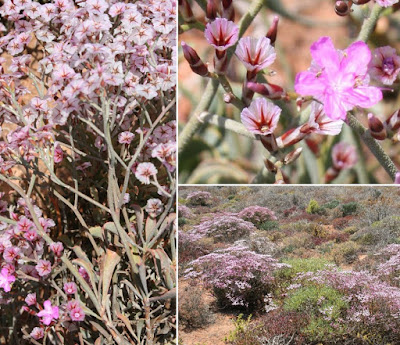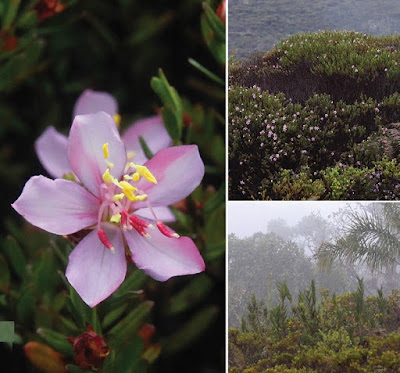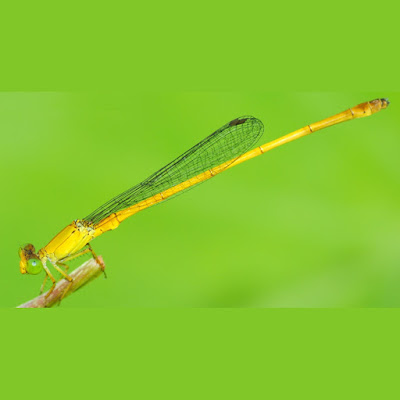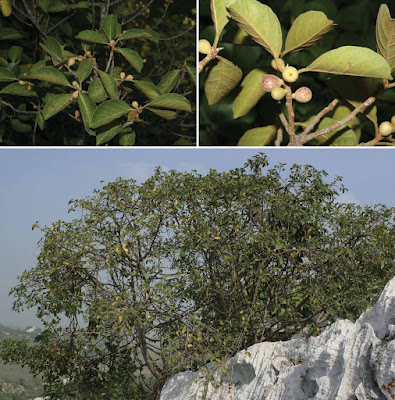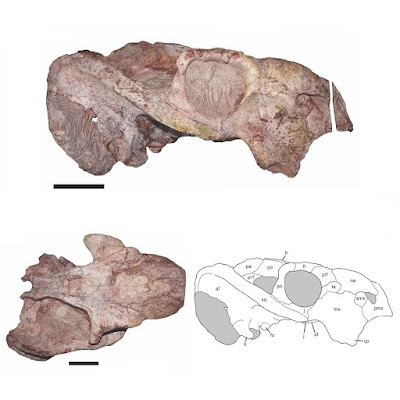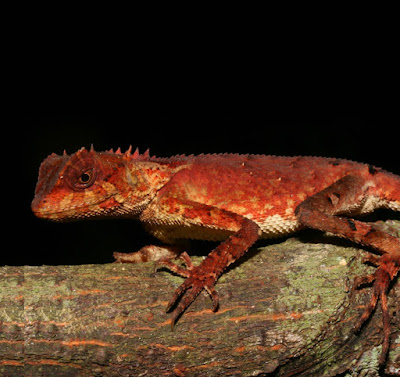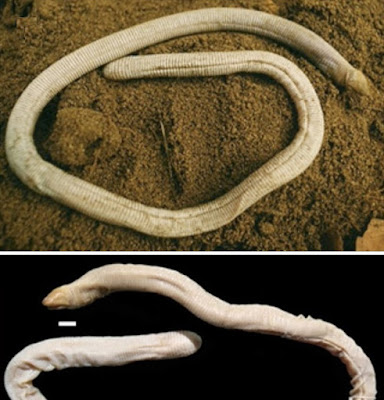[Most Recent Entries] [Calendar View]
Friday, May 31st, 2019
| Time | Event | ||||||
| 1:08a | [Botany • 2019] Limonium dagmarae (Plumbaginaceae) • A New Species from Namaqualand coast, South Africa
Abstract A new species of Limonium from Namaqualand coast, South Africa is here described and named Limonium dagmarae. Shared morphological characters with related South African species place the new species within Limonium sect. Circinaria. Evidence is presented to segregate the new species from relatives based on discrete morphological and environmental characters. The holotype of the L. dagmarae is preserved at NBG. Key words: Afrolimon, Limonium sect. Circinaria, species nova, strandveld, Succulent Karoo Limonium dagmarae Mucina sp. nov. Distribution:— Endemic to the Namaqualand coast, between Doringbaai, Western Cape and Kleinzee, Northern Cape Province (Fig. 3). Etymology:— Named in honour of Dagmar Mucina, the life partner and wife of the first author, in recognition of her indispensable support and her shared passion for the flora of Namaqualand. Ladislav Mucina and Timothy A. Hammer. 2019. Limonium dagmarae (Plumbaginaceae), A New Species from Namaqualand coast, South Africa. Phytotaxa. 403(2); 71–85. DOI: 10.11646/phytotaxa.403.2.1 | ||||||
| 2:07a | [Botany • 2019] Microlicia colombiana (Melastomataceae) • A New Species of Microlicia: First Record of the Genus for Colombia
Abstract Microlicia (Melastomataceae) is a Neotropical genus nearly restricted to southeastern Brazil, and the Guiana Shield in Venezuela, with a few species in some places in the Andes of Bolivia and Peru. A new species of Microlicia endemic to the mountains of eastern Andes of Colombia is described and illustrated. Its affinities with other morphologically similar species from Venezuela are also documented. This novelty is the first record of the genus for Colombia and the northern Andes. It is argued that this disjunct distribution of the genus is attributable to the phenomenon of long-distance seed dispersal by wind. Keywords: Northeastern Andes, endemism, long-distance seed dispersal, northern Andes, sub-páramo Microlicia colombiana Humberto Mend. & R.Romero, sp. nov. Diagnosis: Related to Microlicia benthamiana Triana but differs in having larger internodes, strigose nodes, linear to obovate leaf blades, trichomes between sepals, petals and pedoconective of antesepalous stamens shorter. Also related to Microlicia guanayana Wurdack but differs in having non-strigose adaxial foliar surfaces, 3-nerved leaf blades, hypanthia 10-ribbed, petals < 8.5 mm long and with a rounded setose apex, and stamens with smaller dimensions. TYPE: COLOMBIA. Boyacá: Municipio de Pisba, vereda Miraflores, Sabana de Nubacá, 2389 m elev., ..., 19 Nov 2018 (fl, fr), H. Mendoza & D. Granados 22014 (holotype: FMB!; isotypes: COL!, CUVC!, HUA!, FMB!, CUVC!, UDBC!). Habitat and distribution: Microlicia colombiana is endemic to northeastern Andes of Colombia towards the Orinoquian flank. This species is only known from the type locality in the department of Boyacá near the southern border of Pisba National Natural Park, and a nearby second locality in the department of Casanare, between 2000 to 2400 m elevation (Figure 4A). It grows in open areas of sub-páramo vegetation on white sandy soil covered with sphagnum (Figure 3). Etymology: The specific epithet refers to the restricted occurrence of the new species to Colombia and for being the first record of the genus in this country. Humberto Mendoza-Cifuentes, William Ariza, David E. Granados and Rosana Romero. 2019. A New Species of Microlicia (Melastomataceae): First Record of the Genus for Colombia. PhytoKeys. 122: 87-96. DOI: 10.3897/phytokeys.122.34171 | ||||||
| 2:09a | [Entomology • 2019] Ceriagrion chromothorax • A New Species of Damselfly (Odonata: Zygoptera: Coenagrionidae) from Sindhudurg, Maharashtra, India
ABSTRACT Ceriagrion chromothorax sp. nov. is described from Western Ghats, India, based on six males and one female collected from Sindhudurg District of Maharashtra. Keywords: Damselfly, Devgad, new species, Sindhudurg Marsh Dart, taxonomy, Western Ghats
Ceriagrion chromothorax sp. nov. Common name: Sindhudurg Marsh Dart. Ceriagrion chromothorax sp. nov. is similar to C. coromandelianum, and C. indochinense, the latter has not been recorded from India but could possibly occur in the northeast. The above three species share the character of yellow or olivaceous thoracic and abdominal coloration, but they differ with respect to the shape of their anal appendages, structure of prothorax and mesostigmal plate. Ceriagrion fallax, occurs in northern India but not in western India, it is similar to the three above-mentioned in terms of the yellow abdominal coloration, but is readily distinguishable using the following characters: a) S7–10 extensively black, b) shape of posterior lobe of prothorax and mesostigmal plates, and c) shape of anal appendages. .... Etymology: The name ‘chromothorax’ is given for the bright yellow (=chromo) thoracic coloration. Shantanu Joshi and Dattaprasad Sawant. 2019. Ceriagrion chromothorax sp. nov. (Odonata: Zygoptera: Coenagrionidae) from Sindhudurg, Maharashtra, India. Journal of Threatened Taxa. 11(7); 13875–13885 DOI: 10.11609/jott.4753.11.7.13875-13885 | ||||||
| 2:28a | [Botany • 2019] Ficus pongumphaii (Moraceae) ไทรผ่องอำไพ • A New Species from Thailand, Compared with the Ambiguous Species F. talbotii
Abstract A deciduous shrub previously included in Ficus talbotii for many years, is now regarded as a new species, Ficus pongumphaii. It is morphologically distinct from F. talbotii with as typical characters the densely brown pubescent to tomentose or villous on leafy twig; the elliptic, suborbicular to obovate leaf blades that are brown tomentellous on the upper surface and brown floccose tomentose to villous underneath; the pedunculate figs are obovate, brown floccose or villous outside and have internal hairs. The leaf anatomy shows a multiple epidermis on both surfaces; enlarged lithocysts on both sides of the lamina, which are more abundant adaxially and with very few abaxially. The species, endemic to Thailand, is named after the great Thai dendrologist, Associate Professor Somnuek Pongumphai. Keywords: Ficus; Moraceae; leaf anatomy; new species  Ficus pongumphaii Chantaras. & Sungkaew, sp. nov. Shrub, at least up to 3 m high. Leafy twig brown pubescent to tomentose to villous. Leaf lamina elliptic to suborbicular to obovate, upper surface whitish or brown tomentellous, lower surface brown floccose tomentose to villous. Fig pedunculate, basal bracts persistent, strigose. Receptacle obovate, brown floccose or villous. Synconial internal hairs present. Epidermis multi-layers. Enlarged lithocysts abundant adaxially and only few abaxially. — Type: B. Chantarasuwan 180910-4 (holo THNHM; iso L), Thailand, Lop Buri, Thawung, Wat Khao Samorkhorn, 18 Sept. 2010. Distribution & Habitat — A species seemingly endemic to Thailand, occurring on limestone hills at a 30–600 m elevation.   Bhanumas Chantarasuwan, Sarawood Sungkaew, Kanchana Pruesapan, Pieter Baas and P.C. van Welzen. 2019. Ficus pongumphaii (Moraceae), A New Species from Thailand, Compared with the Ambiguous Species F. talbotii. Blumea - Biodiversity, Evolution and Biogeography of Plants. DOI: 10.3767/blumea.2019.64.02.02 | ||||||
| 3:05a | [Paleontology • 2019] Ufudocyclops mukanelai • A New Kannemeyeriiform Dicynodont from Subzone C of the Cynognathus Assemblage Zone, Triassic of South Africa, with Implications for Biostratigraphic Correlation with other African Triassic Faunas
ABSTRACT A new taxon of kannemeyeriiform dicynodont, Ufudocyclops mukanelai, is described based on a well-preserved skull from Subzone C of the Cynognathus Assemblage Zone, which are the youngest strata (probably Middle Triassic) of the Beaufort Group (uppermost Burgersdorp Formation) in South Africa. Ufudocyclops mukanelai is diagnosed by its autapomorphic intertemporal morphology: the intertemporal bar in this taxon is ‘X’-shaped—broad anteriorly and posteriorly but distinctly ‘pinched’ at mid-length and bears a deep, triangular depression immediately behind the enormous pineal foramen. The new kannemeyeriiform can also be diagnosed by the presence of a laterally expanded jugal plate beneath the orbit, and highly discrete, ovoid nasal bosses separated by a broad, unornamented median portion of the premaxilla and the nasals. Two partial dicynodont skulls from this subzone, previously identified as specimens of the otherwise Tanzanian taxon Angonisaurus, are also referable to U. mukanelai. Removal of these specimens from the hypodigm of Angonisaurus eliminates a crucial point of correlation between Cynognathus Subzone C and the Manda Beds of Tanzania and suggests that Subzone C preserves a distinct, endemic fauna, not just a southern extension of the better-known Middle–Late Triassic tetrapod faunas from Tanzania and Zambia. Inclusion of Ufudocyclops in a phylogenetic analysis of anomodonts recovers it as an early stahleckeriid, the first record of this clade from the Cynognathus Assemblage Zone. SYSTEMATIC PALEONTOLOGY SYNAPSIDA Osborn, 1903 THERAPSIDA Broom, 1905 ANOMODONTIA Owen, 1860 DICYNODONTIA Owen, 1860 KANNEMEYERIIFORMES Maisch, 2001 STAHLECKERIIDAE Lehman, 1961 UFUDOCYCLOPS MUKANELAI, gen. et sp. nov. Etymology— From the Xhosa ufudo, meaning tortoise (in reference to the toothless, tortoise-like beak), and the Ancient Greek cyclops, a one-eyed mythological giant (in reference to the enormous opening for the pineal eye on the dorsal midline of the skull). Species named in honor of Mr. Pepson Mukanela, in recognition of his many years working in the preparatory laboratory of the Evolutionary Studies Institute (and its predecessor, the Bernard Price Institute for Palaeontological Research) and in particular his skillful preparation of BP/1/8208. Christian F. Kammerer, Pia A. Viglietti, P. John Hancox, Richard J. Butler and Jonah N. Choiniere. 2019. A New Kannemeyeriiform Dicynodont (Ufudocyclops mukanelai, gen. et sp. nov.) from Subzone C of the Cynognathus Assemblage Zone, Triassic of South Africa, with Implications for Biostratigraphic Correlation with other African Triassic Faunas. Journal of Vertebrate Paleontology. DOI: 10.1080/02724634.2019.1596921 | ||||||
| 3:23a | [Herpetology • 2019] Acanthosaura phongdienensis • A New Species of Acanthosaura Gray 1831 (Reptilia: Agamidae) from central Vietnam
Abstract Herein, we describe the new agamid species Acanthosaura phongdienensis sp. nov. from central Vietnam based on morphological and genetic data. Males of the new medium-sized species have a snout-vent length of up to 77.4 mm and females up to 64.7 mm. In both genders, the tail is longer than the snout-vent length. A spine occurs on each side of the neck, the rostral scute is entire, and the nuchal and dorsal crests are continuous. A postorbital spine is about half as long as the diameter of the eye-ball, and small lateral scales intermix with large, keeled scales whose tips point backwards and upwards. The new species differs genetically from the closely related species A. brachypoda, A. coronata, and A. lepidogaster by uncorrected p-distances of 13.6%, 21.7%, and 12.8%, respectively. This is the 13th species of Acanthosaura and the eighth species in the genus from Vietnam. Keywords: Reptilia, Agamid, Acanthosaura lepidogaster, Phong Dien, COI Sang Ngoc Nguyen, Jie-Qiong Jin, Ba Dinh Vo, Luan Thanh Nguyen, Wei-Wei Zhou, Jing Che, Robert W. Murphy and Ya-Ping Zhang. 2019. A New Species of Acanthosaura Gray 1831 (Reptilia: Agamidae) from central Vietnam. Zootaxa. 4612(4); 555–565. DOI: 10.11646/zootaxa.4612.4.7 | ||||||
| 3:01p | [Herpetology • 2019] Redescription of Leposternon octostegum (Duméril, 1851), with An Identification Key for Brazilian Leposternon species (Squamata: Amphisbaenidae), Remarks on Meristic Methodology, and A Proposal for Pholidosis Nomenclature
ABSTRACT The amphisbaenian Leposternon octostegum (Duméril, 1851) is redescribed based on newly collected material from the state of Bahia, Brazil. Species validity was confirmed, and comparisons made to other Leposternon species and to the scarce literature available on Leposternon octostegum taxonomy. Aspects of meristic annuli methodology are reviewed, and nomenclatural adjustments for some scales are proposed. To place this information in its taxonomic context, a species identification key for the Brazilian species of the genus Leposternon is provided. The present redescription contributes to a better understanding of Amphisbaenia taxonomy, thus also enabling the design of more adequate conservation and management strategies for the species belonging to this group. Keywords: Amphisbaenia, Bahia, Brazil, Leposternon octostegum, meristic methodology, pholidosis nomenclature, taxonomy Leposternon octostegum (Duméril) Amphisbaena octostega (Duméril) Lepidosternon octostegum Duméril, 1851, p. 150–151. Terra typica: “Brésil”. Holotype: MNHN 7055. Diagnosis: A species of Leposternon with an enlarged, polygonal azygous shield atop the head, which, however, does not exclude the discrete prefrontals, oculars and first temporals shields of the dorsal cephalic area posterior to the rostronasal; one large supralabial and one large infralabial shield on each side of mouth; a large mental shield (postmental shield absent, probably fused with the mental shield); 353–382 ventral, postpectoral half-annuli. Definition: A slender, medium-sized (388mm maximum adult total length) form of Leposternon, with an enlarged, polygonal azygous shield atop the head; in dorsal view, the rostronasal, the prefrontals, the oculars, the first temporals and a small pair of occipitals are also clearly discernible; one large supralabial and one large infralabial; mental and postmental shields, probably fused; three pairs of enlarged shields along the midline, with left and right asymmetries: the anterior pair forms a rough stretched pentagon pointing backwards, the second pair has irregular polygons tending to a medial suture in an “X” disposition and the posterior pair showing polygonal transversely elongated shields, larger caudad than rostrad; 353–382 ventral, 357–397 dorsal postpectoral half-annuli; 24–33 dorsal half-annuli scales; 23–29 ventral half-annuli scales; 12–15 caudal annuli; a short, cylindrical and round ending tail; 121–142 precloacal vertebrae; absent precloacal pores and autotomy. Living specimens have a pale grizzled background coloration, with none or inconspicuous sparse, diminute and irregularly distributed dorsal brownish pigments, more concentrated in the second half of the body (Image 23A). Alcohol preserved specimens display a more pale brown (beige) brownish or whitish background coloration, and the pigments are more subtle. The sample from Municipality of Camaçari exhibited a different coloration, with marked brownish blotches or dorsal pigment dots evident along most of the body and in the tail. José Duarte de Barros-Filho, Marco Antonio de Freitas, Thais Figueiredo Santos Silva, Mariana Fiuza de Castro Loguercio and Maria Celeste Costa Valverde. 2019. Redescription of Leposternon octostegum (Duméril, 1851), with An Identification Key for Brazilian Leposternon species, Remarks on Meristic Methodology, and A Proposal for Pholidosis Nomenclature (Squamata: Amphisbaenidae). Journal of Threatened Taxa. 11(1); 13058-13086. DOI: 10.11609/jott.3597.11.1.13058-13086 |
| << Previous Day |
2019/05/31 [Calendar] |
Next Day >> |
